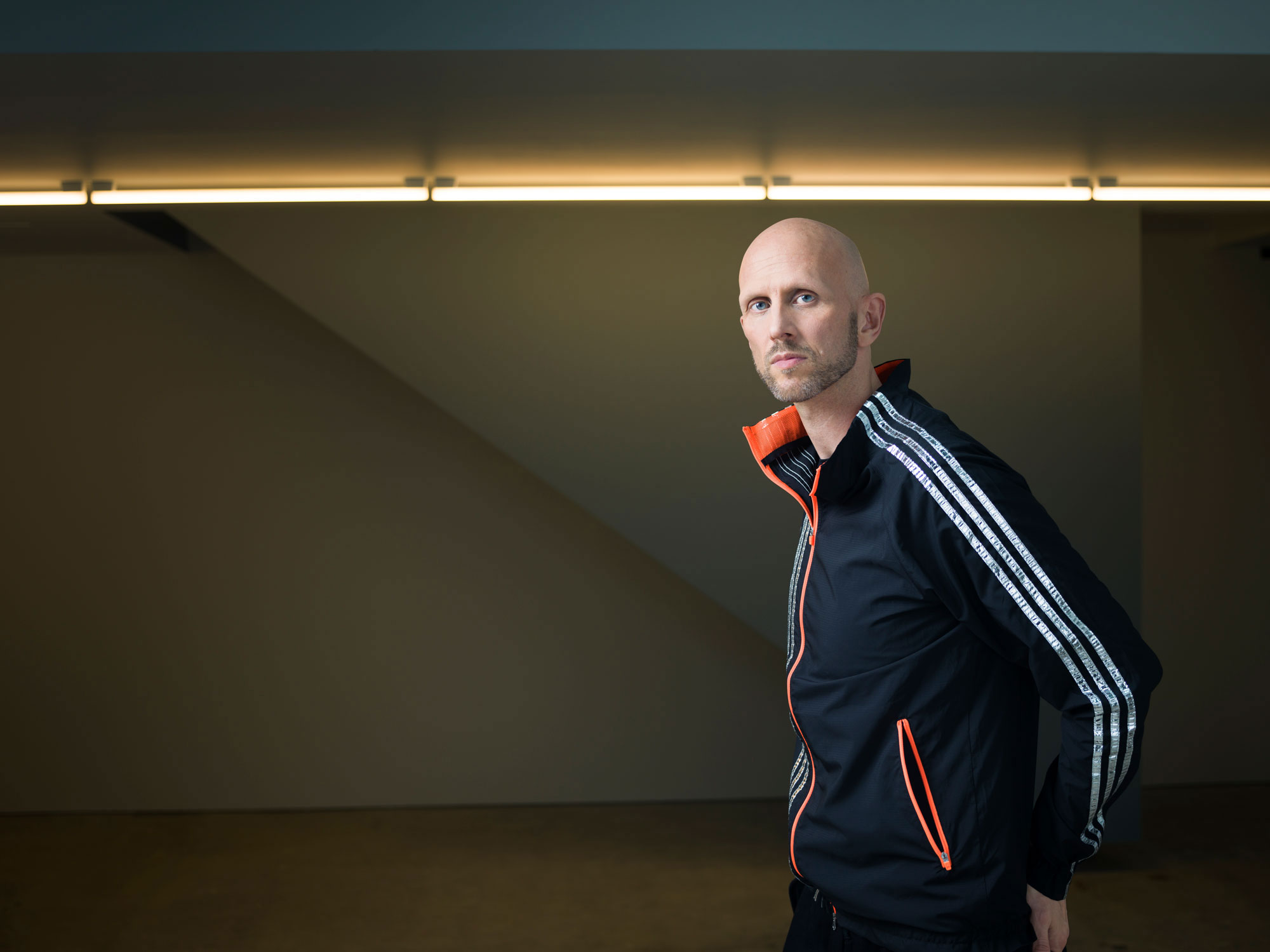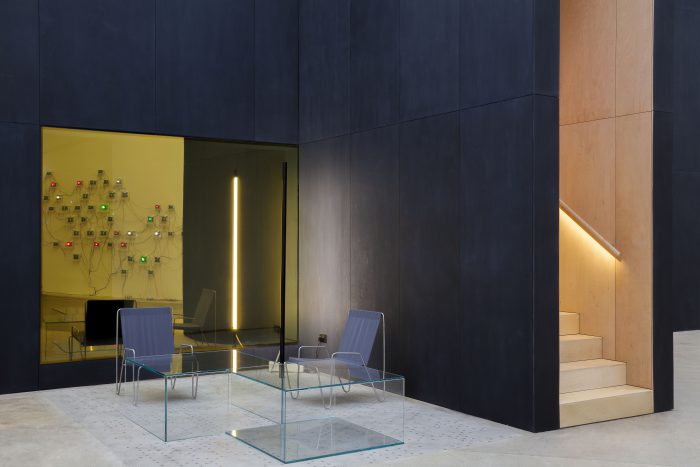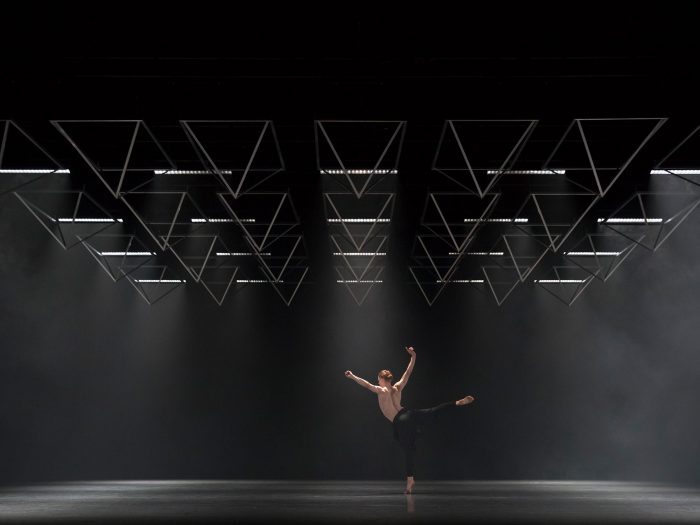



It’s reductive to distil any human life into a singular narrative – opening, mid-section, grand finale – reality is never quite that tidy. Wisely, with his latest work Autobiography, choreographer Wayne McGregor CBE (Performance and Cultural Industries 1991, Hon DLitt 2016), resists such interpretations with a system that also averts repetition.
Wayne’s Autobiography represents the fluidity of his life with a series of choreographed scenes, or ‘volumes’, which are informed by pieces of art, dance and literature, as well as treasured photographs. A different selection of volumes is chosen by an algorithm for each performance – re-interpreting his past, present and future anew every time.
But this being renowned polymath Wayne, it goes deeper, for at the bold heart of Autobiography is his very own genetic code. Company Wayne McGregor worked with the Wellcome Trust Sanger Institute to forge the algorithm, which chooses from the 23 volumes that share aspects of the life of Wayne.
That’s 23, as in pairs of chromosomes. It’s Wayne’s biology, his flesh made data by technology, which dictates the structure of the performance – as our codes shape our lives – with the emotions, the humanity, generated from the 10 performing dancers’ embodied interpretations.
Seen live, Autobiography, which premiered at Sadler’s Wells in the autumn, is profoundly impactful – those background machinations never once detracting from its emotional resonance.
But such artistry is hard to translate to the page, and so lacking an algorithm, a beginning for this story must be person-picked: Bretton Hall, 1988.
Then 18, Stockport native Wayne had been dancing for 11 years, inspired to take classes by John Travolta’s liquid moves in Saturday Night Fever and Grease. He’d already been teaching dance, including his own choreography, for six years. Alongside his inherent love for physical expression and a lifelong urge to move his body, whether in sport or to music, he was drawn to technology, spending hours coding as a teen.
Insatiably curious, Wayne was primed for inspiration, whatever the medium, as he embarked on a degree in Choreography and Semiotics at Bretton Hall College. Bretton Hall, affiliated with the University of Leeds, imbued creativity with a liberal education ethos.
A life-long impression was made by Bretton Hall’s beautifully-wrought, capacious Georgian architecture and breathtaking landscape. At Bretton, students rambled round the vast natural setting where artwork emerged from the ground (part of the Yorkshire Sculpture Park) and boaters paddled on a man-made lake. Bretton Hall was a glorious, isolated, place. But from its mansion, perched on top of a hill, one could see for miles.
“We did as much of our work on site locations in the grounds as we did in a room,” Wayne recalls. “It’s really important not to always be surrounded by four walls… Many of our performances were around the sculpture exhibitions in the park. That whole relationship between space, body, earth and buildings was really different. It changed the way I think about bodies and spaces.”
Bretton Hall’s progressive approach to learning translated into a choreographic degree unlike any other. Taught by professional choreographers, the course focused on contemporary dance techniques (rather than classical ones such as ballet), resulting in innovative training in working with the body.
Wayne thrived with the freedom to craft his own pieces. Bretton Hall students were taught how to use dance in social contexts, which led to them working with youth groups, in hospitals and in prisons.
Duly invigorated, Wayne followed his time at Bretton Hall with a stint at New York’s Avant garde Dance Foundation where he was enthralled by dance’s postmodern revolution. Avant garde choreographer and interdisciplinary iconoclast, Merce Cunningham, would perform live – accompanied by equally intrepid composer, John Cage – at the Lincoln Centre.
Wayne returned to the UK committed to forging a unique creative path. His first job: Community dance animateur for the London Borough of Redbridge, where he assisted groups through movement-based learning. He remains a fervent believer in the power of dance to bolster lives, bond communities and foster regeneration. More than 90,000 people have participated in the Learning and Engagement programmes on offer by his Company in its new state of the art East London home, Studio Wayne McGregor.
Originally called Random Dance in a bid to stymie assumptions about its intentions, Company Wayne McGregor was formed in 1992. Wayne’s talent saw him hired as Choreographer in residence at forward-thinking London dance institute, The Place, soon after. Over the next decade, Random Dance’s repertoire and reputation grew steadily, culminating in it becoming Sadler’s Wells’ first Company in Residence in 2001.
About that time, Wayne turned to social and cognitive scientists in his drive for greater understanding of his art form and the intelligence of the body. These pursuits have led to academic positions including a professorship of choreography at Trinity Laban Conservatoire of Music and Dance.
This one-time teenage coder has developed artificially intelligent choreographic software and created choreographic tools alongside scientists at the Wellcome Trust. The latter project not only fed into Company members’ training and its educational resources, but was also exhibited at the Wellcome Trust as Thinking with the Body: Mind and Movement in the Work of Wayne McGregor (2013).
Wayne is the only person without a classical background to hold the position of Resident choreographer at The Royal Ballet, where he has consistently upended expectations about what ballet can be.
Wayne’s multi-award-winning creations include the groundbreaking Chroma (2006), which featured music by Joby Talbot and The White Stripes and set design by acclaimed architect John Pawson. More recently, Wayne’s first full-length work for the revered company, an interpretation of a triptych of writings by Virginia Woolf to music by electronic impresario Max Richter, Woolf Works (2015), floored critics and fans alike.
With Company Wayne McGregor, he has continued to produce astounding creations – more than 30 so far. Tree of Codes (2015) was inspired by Jonathan Safran Foer’s literary artwork and featured dancers from the Paris Opera Ballet, as well as lighting by fellow Renaissance man, Olafur Eliasson, all set to music by Jamie XX.
Human +/-, performed at London’s Roundhouse, saw drones dancing with the human cast, as well as members of the public. The involvement of electronic musicians, established artists, robotics and regular folk is telling of Wayne’s boundless ambition and adoration of culture in any guise.
So although it’s impossible to predict where Wayne’s artistic, scientific and technological endeavours will lead, rest assured countless more wonder-making works lie in store as this evolving autobiography continues to be retold.

